Original article by Peter J. Koehler published 13 September 2019 in World Neurology Vol 34 No.46
Original article by Peter J. Koehler published 13 September 2019 in World Neurology Vol 34 No.46

Steno (by Justus Sustermans; public domain).
A number of medical students of human and animal bodies in the 17th century demonstrated a critical attitude toward the knowledge that was taught in books and by their teachers. Although inspired by the new mechanistic or iatrophysical physiology of René Descartes (1596-1650), they not only questioned the anatomical and physiological views of previous generations of anatomists and physicians (including Thomas Willis), but also Descartes' own ideas. In this essay, I will discuss two of these critical young men.
Danish Student Discovering a Duct
One was born and raised in Copenhagen, Denmark, where one of his teachers, the physician Thomas Bartholin (1616-1680) advised him to go to Holland, in particular Amsterdam. Armed with a letter of recommendation from Bartholin, the young man was welcomed by Gerard Blaes (Blasius, 1627-1682) who gave him lodging, a frequent custom at the time, and taught him anatomy.

Title page of Descartes' De Homine (1662).
The relationship was soon disturbed, when the young man discovered a new anatomical structure in the head of a sheep, notably the duct of the parotid salivary gland that became eponymously related with his name: Niels Stensen (Steno, 1638-1686). His teacher Blaes, at several occasions, tried to turn the discovery to his own advantage. A few months later, Stensen continued his studies at Leiden University, where he was taught by Johannes van Horne (1621-1670) and Frans deleBoë (Sylvius, 1614-1672); his name is remembered in the term Sylvian fissure, both considered modern professors, stimulating practical research, in contrast to the men of learning, who kept to the old philosophy of Aristoteles.
Although the new philosophy of Descartes, who had stayed in the Netherlands for a large part of his career, had inspired him as well as many other scholars, and his world view incited study of the individual phenomena, Stensen found that many of his ideas were speculative. Mathematician/physicist and astronomer Christiaan Huygens (1629-1695), for instance, found that mechanical laws, upon which Descartes founded his physics, were not correct. Descartes obviously had put into perspective the significance of observation as the senses were fallible, but this seemed to be truth also for the power of reason.
The criticism increased by the posthumous publication of Descartes' book on the functions of the human body, Tractatus de Homine (1662). Descartes had written the discourse already in 1632, but did not publish it, fearing the inquisition (as Galilei had experienced in Italy, 1632). Descartes had written his discourse to show that the function of the human body could be comprehended in mechanistic terms, controlled by the brain by means of the nervous system.
Dutch Student Making a Nerve-Muscle Preparation
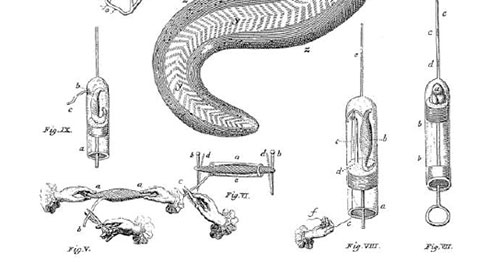
Swammerdam's nerve-muscle preparation from the posthumously published Bybel der natuure of historie der insecten [Bible of nature or history of insects] (1737).
This inspired Stensen. He decided to study the structure and physiology of the brain. He soon found that the old idea of spirits conducted by nerves to control the muscles, an old Galenic concept, was difficult to prove. Around the same time, another Leiden medical student worked on the same problem. Son of an Amsterdam pharmacist, he started his medical studies in Leiden in 1661, doing research on respiration with Frans deleBoë. The old view was still that the function of the lungs was to cool the blood. According to Galen, the heart had an innate warmth, with which organisms were born and which was the source of body warmth. DeleBoë changed the view based on his iatrochemical ideas, effervescence by the combination of acid and alkaline substances. Working on respiration, the student also had to study (frog) muscles and found that touching the nerve, even of a frog leg disconnected from the body, produced muscle contractions.

As there is no existing portrait of Swammerdam, the title page of his Historia Insectorum Generalis ofte Algemeene Verhandeling van de Bloedeloose Dierkens [General treatise of the bloodless animals] (1669) is shown here.
Like Stensen, he realized this was not in accordance with the idea of spirits being conducted by (hollow) nerves to the muscles. He observed similar phenomena while studying the diaphragm of living dogs. How could this be explained by material sent to the muscle from the brain so fast? Therefore, he devised an ingenious experiment with a muscle-nerve preparation in a glass tube, by which he was able to prove that no material was blown into the muscle upon contraction at all. His experiment stirred amazement, and several colleagues, including Stensen, visited his Leiden room, where he, Jan Swammerdam (1637-1680), as some of you may now have realized, demonstrated this and other experiments. Stensen told Bartholin about what he had seen in springtime of 1663.
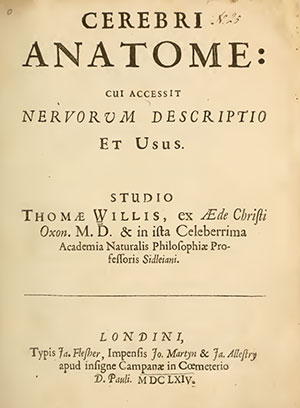
Thomas Willis' Cerebri Anatome (1664).
Clearly, Swammerdam and Stensen had a kindred spirit, both believing in their own critical insights to come to new knowledge, not merely accepting the ideas of previous generations. In this way, Stensen, experimenting with animals, found that the heart was a muscle and not an organ that produced heat.
Criticizing Willis and Descartes
Another subject Stensen wished to study was the anatomy and function of the brain. He experienced it was difficult to deduct its function from the anatomy. He reacted critically, when Thomas Willis' (1621-1675) Cerebri Anatome was published (1664). Although it contained accurate anatomical plates (by Christopher Wren), and Willis described the well-known arterial circle (now known by the name circle of Willis) at the base of the brain, suggesting its function ("The joynings together of the Carotides, in most living Creatures, are made about the Basis of the Skull under the Dura Mater…"), Stensen was particular critical about his speculative discussion of the function of the brain.
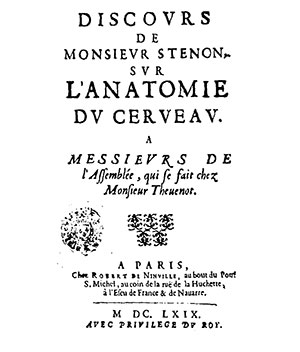
Steno's Discours sur l'anatomie du cerveau(published 350 years ago in 1669).
Both Descartes and Willis still adhered to the concept of spiritus animalis, being conducted by the ventricles and nerves, the first explaining it in a mechanical way (iatrophysical physiology), the second by chemical (iatrochemical physiology). He believed the little progress that had been made with respect to the knowledge of brain function was due to the fact that most physicians used the ancient doctrines as points of departure, rather than critically describing what was observed, although he realized that the methods available to study the brain were insufficient due to its soft structure.
These and other comments, Stensen presented in a lecture on the anatomy of the brain in Paris (1665, then 27 years old and already well-known), at wealthy amateur scientist and patron of many scientists Melchisédech Thévenot's (1620-1692) group. It was published only in 1669 (350 years ago) with the title Discours sur l'anatomie du cerveau (à Messieurs de l'Assemblée de chez Monsieur Thevenot). He started the lecture in an unusual way: "Au lieu de vous promettre de contenter votre curiosité, touchant l'Anatomie du Cerveau; ie vous fais icy une confession sincere & publique, que ie n'y connois rien » [Instead of promising you to satisfy your curiosity, with respect to the brain; I here have to confess sincerely and in public that I do not know anything about it].
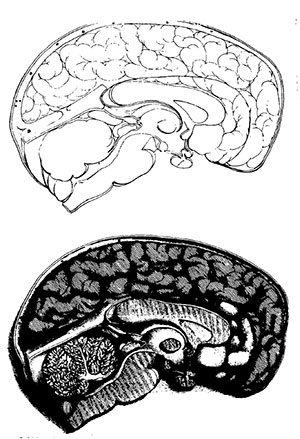
From Steno's Discours (1669).
He ended the lecture by presenting suggestions how to continue research. The brain should be described accurately paying attention to all its aspects, including anatomy, embryology, comparative anatomy, function, etc. "Dans les animaux vivans, il y a a considerer toutes les choses que peuvent causer quelque alteration aux actions du cerveau, soit qu'elles viennent du dehors, comme les liqueurs, les blessures, les medicamens ; soit que les causes soient internes, commes les maladies, dont la medecine compte un grand nombre » [In living animals, one may consider all things that may cause any change to the actions of the brain, whether they may come from outside, as fluids, injuries, medicines; or be it internal causes, as diseases of which medicine counts a large number].
The publication was commented upon in the Transactions of the Royal Society(September 20, 1669) in which we find a three-page summary, containing the sentence "Next, he entertains the reader with an enumeration of the chief errors of anatomists touching the brain. And here he examins particularly the Systemes of dr. Willis and Monsieur Des Cartes."
Stensen as well as Swammerdam were both sponsored by Thévenot, and the three worked together in 1665. Stensen moved to Florence in 1666, where he stayed with the Grand Duke of Tuscany, Ferdinando II) and his brother (Leopoldo de Medici), both interested in science, founding the Accademia del Cimento [Academy of Experiments] in 1657. Here, he published his Elementorum myologiae specimen, including detailed descriptions of the structure and contraction of muscles (1667). The work, however, was severely criticized by Mayow, Borelli, Bernoulli, and Boerhaave.
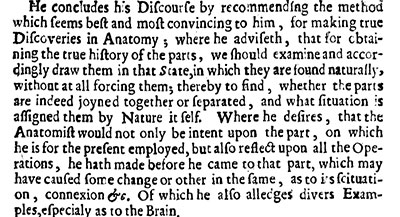
Section from the review of Steno's Discours in Transactions of the Royal Society (September 20, 1669).
Interestingly, both Stensen and Swammerdam never practiced medicine. They made a religious turn in their lives. Although born in an orthodox Lutheran family, Stensen converted to Catholicism in 1667. Later, he became a priest and bishop in northern Germany. He died in Schwerin in 1686 (age 48). Swammerdam became depressive, possibly related to a long-lasting conflict with his father on providing means of sustaining life, but also by doubts about his future and a possible marriage. He became a member of the religious community of mystic Antoinette Bourignon (1616-1680). The last years of his life, he studied insects often using small microscopes that he made himself. He died in 1680 (age 43). His first biographer (Leiden professor Herman Boerhaave) published his Bybel der natuure of historie der insecten [Bible of nature or history of insects] in 1737, in which we find the experiments described above. ■
Literature
- Kardel T. Steno. Life – Science – Philosophy. Acta Historica Scientiarum Naturalium et Medicinalium. 1994;42:1-159.
- Kooijmans L. Gevaarlijke kennis. Inzicht en angst in de dagen van Jan Swammerdam. [Dangerous knowledge. Insight and fear in the days of Jan Swammerdam] Houten, Bohn, Stafleu Van Loghum, 2007
- Stensen N. Discours sur l'anatomie du cerveau à Messieurs de l'Assemblée de chez Monsieur Thevenot. Paris, Robert de Ninville, 1669.
- Swammerdam J. Bybel der natuure of historie der insecten [Bible of nature or history of insects]. Leiden, Severinus et al., 1736








